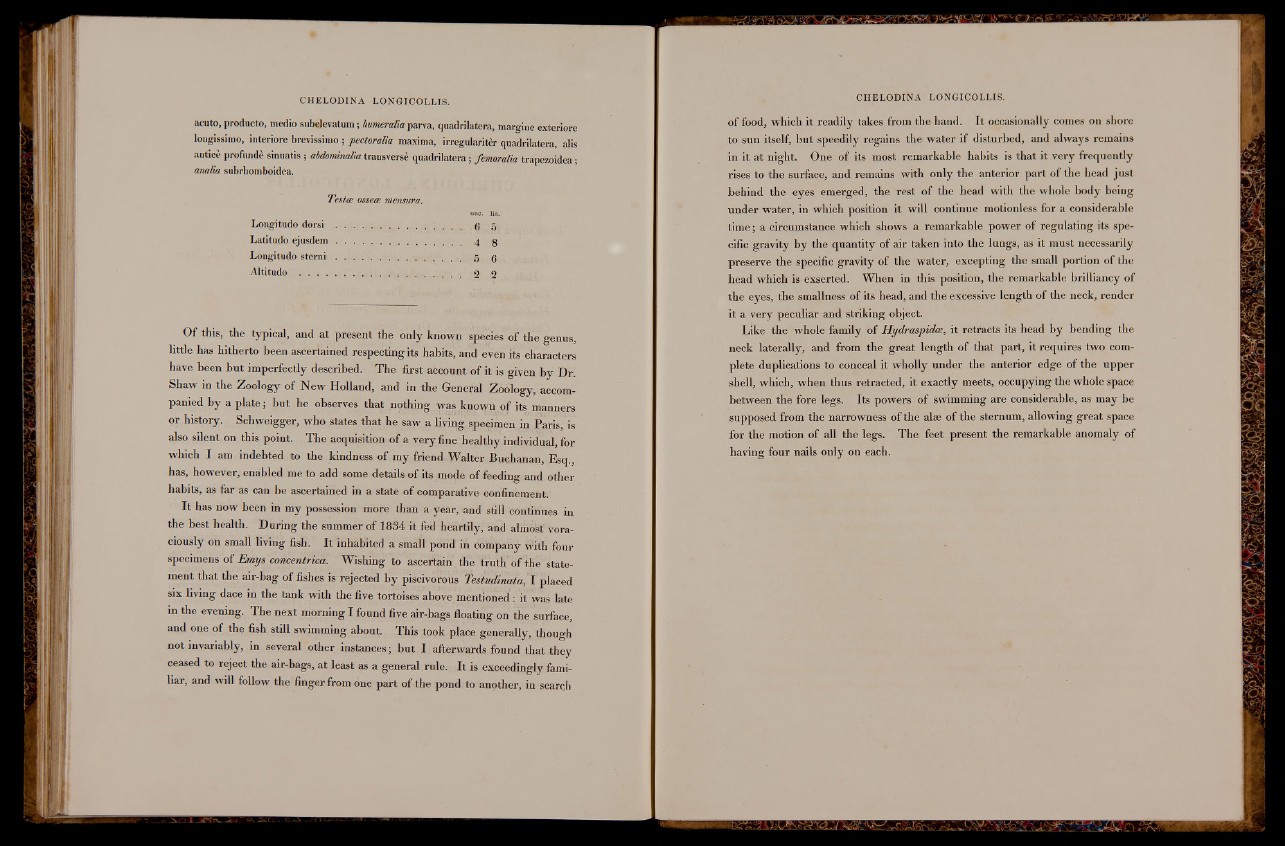
acuto, producto, medio subelevatum ; humeralia parva, quadrilatera, margine exteriore
longissimo, interiore brevissimo ; pectoralìa maxima, irregularitèr quadrilatera, alis
anticè profundé sinuatis ; abdominalia transverse quadrilatera ; femoralia trapezoidea ;
analìa subrhomboidea.
T esta ossea mensura.
. uiic. lin.
Longitudo dorsi . ................. . . . . . . . Q jy
Latitudo ejusdem.................................................. 4 g
Longitudo s t e r n i . . 5 6
Altitudo ........................................- . . . 2 2
Of this, the typical, and at present the only known species of the genus,
little has hitherto been ascertained respecting its habits, and even its characters
have been but imperfectly described. The first account of it is given by Dr.
Shaw in the Zoology of New Holland, and in the General Zoology, accompanied
by a plate; but he observes that nothing was,known of its manners
or history. Schweigger, who states that he saw a living specimen in Paris, i
also silent on this point. The acquisition of a very fine healthy individual, for
which I am indebted to the kindness of my friend Walter Buchanan, Esq.,
has, however, enabled me to add some details of its mode of feeding and other
habits, as far as can be ascertained in a state of comparative confinement.
It has now been in my possession more than a year, and still continues in
the best health. During the summer of 1834 it fed heartily, and aliiio'sf voraciously
on small living fish. It inhabited a small pond in company with four
specimens of Emys concentrica. Wishing to ascertain the truth of the statement
that the air-bag of fishes isTejected by piscivorous Tesludinatafi placed
six living dace in the tank with the five tortoises above mentioned : it was late
in, the evening. The next morning I found five air-bags floating on the, surface,
and one of the fish still swimming about. This took place generally, though
not invariably, in several other instances; but I afterwards found that they
ceased to reject the air-bags, at least as a general rule. It is exceedingly familiar,
and will follow the finger from one part of the pond to another, in search
of food, which it readily takes from the hand. It occasionally comes on shore
to sun itself, but speedily regains the water if disturbed, and always remains
in it at night. One of its most remarkable habits is that it very frequently
rises to the surface, and remains with only the anterior part of the head just
behind the eyes emerged, the rest of the head with the whole body being
under water, in which position it will continue motionless for a considerable
time ; a circumstance which shows a remarkable power of regulating its specific
gravity by the quantity of air taken into the lungs, as it must necessarily
preserve the specific gravity of the water, excepting the small portion of the
head which is exserted. When in this position, the remarkable brilliancy of
the eyes, the smallness of its head, and the excessive length of the neck, render
it a very peculiar and striking object.
Like the whole family of Hydraspidoe, it retracts its head by bending the
neck laterally, and from the great length of that part, it requires two complete
duplications to conceal it wholly under the anterior edge of the upper
shell, which, when thus retracted, it exactly meets, occupying the whole space
between the fore legs. Its powers of swimming are considerable, as may be
supposed from the narrowness of the alæ of the sternum, allowing great space
for the motion of all thé legs. The feet present the remarkable anomaly of
having four nails only on each.